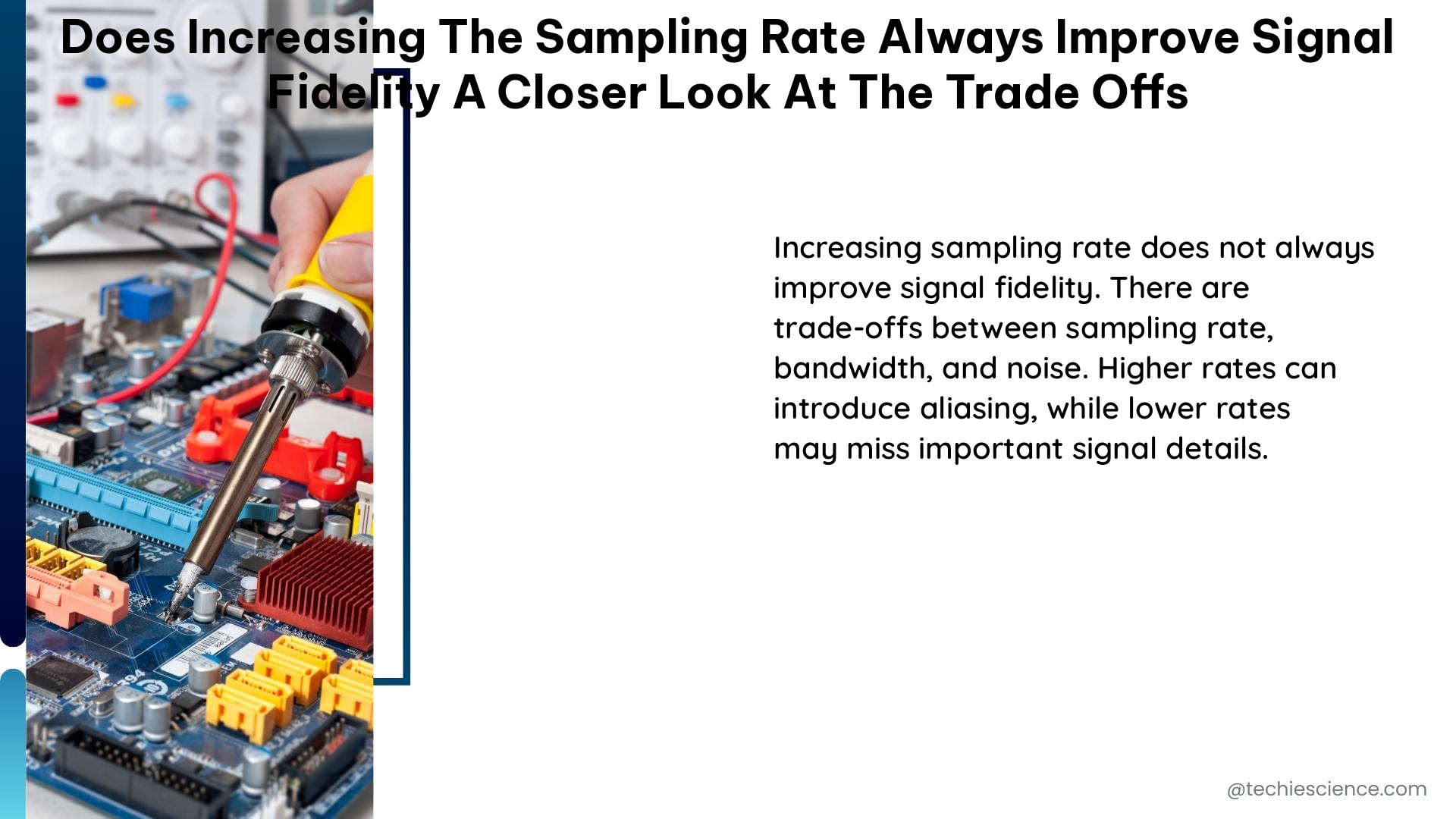Increasing the sampling rate can indeed improve signal fidelity, but it also comes with significant trade-offs in terms of resource utilization, processing complexity, and potential for aliasing. In this comprehensive guide, we’ll dive deep into the technical details and quantifiable data to help you understand the nuances of this fundamental concept in signal processing.
The Nyquist-Shannon Sampling Theorem: The Foundation
The Nyquist-Shannon Sampling Theorem is a cornerstone of signal processing, establishing a relationship between the sampling rate and the bandwidth of a signal. According to this theorem, if a continuous-time signal is band-limited and the sampling rate is at least twice the signal bandwidth, the signal can be uniquely represented in its samples and retrieved back from them without any loss of information. This minimum sampling rate is referred to as the Nyquist rate.
The mathematical representation of the Nyquist-Shannon Sampling Theorem is as follows:
Fs >= 2Fmax
where Fs is the sampling frequency (or sampling rate), and Fmax is the highest frequency component present in the baseband signal.
Sampling Rates in Real-World Applications

Let’s explore some real-world examples to understand the practical implications of the Nyquist-Shannon Sampling Theorem.
Hearing Aids
In the context of hearing aids, audio sampling rates typically range between 20 kHz and 33.1 kHz. For instance, a 20 kHz sampling rate has a Nyquist frequency of 10 kHz, allowing frequencies up to 10 kHz to be represented. Similarly, a 33 kHz sampling rate allows frequencies up to 16.5 kHz. It’s important to note that these sampling rates are at the input stage; later in the processing pathway, the signal may be down-sampled to save processing capacity, before being up-sampled again.
Neural Recording
In the field of neural recording, a study on wired-OR compressive readout architecture found that for an event signal-to-noise ratio (SNR) of 7-10, the wired-OR approach correctly detects and assigns at least 80% of the spikes with at least 50× compression. This demonstrates the trade-off between compression ratio and task-specific signal fidelity metrics in neural recording applications.
Numerical Examples: Balancing Sampling Rate and Bandwidth
Let’s consider a specific example to illustrate the trade-offs involved in selecting the sampling rate.
Suppose we have a signal with a bandwidth of 5 kHz. To satisfy the Nyquist-Shannon Sampling Theorem, the sampling rate must be at least 10 kHz (twice the bandwidth). If we increase the sampling rate to 20 kHz, the signal can be represented more accurately, but this comes at the cost of increased processing complexity and resource utilization.
The table below highlights the trade-offs:
| Sampling Rate | Nyquist Frequency | Bandwidth Representation | Processing Complexity | Resource Utilization |
|---|---|---|---|---|
| 10 kHz | 5 kHz | Minimum required | Lower | Lower |
| 20 kHz | 10 kHz | More accurate | Higher | Higher |
As you can see, while increasing the sampling rate can improve signal fidelity, it also leads to a higher processing complexity and resource utilization, which may not always be desirable or feasible, especially in resource-constrained systems.
Aliasing: The Downside of Insufficient Sampling
One of the key trade-offs to consider when selecting the sampling rate is the potential for aliasing. Aliasing occurs when the sampling rate is not high enough to capture all the frequency components present in the signal, leading to the appearance of false, lower-frequency components in the sampled signal.
To mitigate the effects of aliasing, it is essential to ensure that the sampling rate is at least twice the highest frequency component in the signal, as per the Nyquist-Shannon Sampling Theorem. Failure to do so can result in significant distortion and loss of information in the reconstructed signal.
Compression and Signal Fidelity: A Balancing Act
In some applications, such as neural recording, there is a trade-off between data compression and signal fidelity. The study on wired-OR compressive readout architecture mentioned earlier demonstrates this balance, where a 50× compression ratio still maintains at least 80% spike detection and assignment accuracy for an event SNR of 7-10.
This highlights the importance of carefully considering the specific requirements and constraints of the application when determining the optimal sampling rate and balancing it with other signal processing techniques, such as compression, to achieve the desired level of signal fidelity.
Conclusion
In summary, while increasing the sampling rate can indeed improve signal fidelity, it is essential to consider the trade-offs involved, such as processing complexity, resource utilization, and the potential for aliasing. By understanding the Nyquist-Shannon Sampling Theorem and the practical implications in various applications, you can make informed decisions to strike the right balance between signal fidelity and system-level constraints.
References
- Pumiao Yan, Arash Akhoundi, Nishal P. Shah, Pulkit Tandon, Dante G. Muratore, E.J. Chichilnisky, and Boris Murmann, “Data Compression versus Signal Fidelity Tradeoff in Wired-OR Analog-to-Digital Compressive Arrays for Neural Recording,” IEEE Transactions on Biomedical Circuits and Systems, 2023.
- Laura Winther Balling, Lars Dalskov Mosgaard, and Dana Helmink, “Signal Processing and Sound Quality,” The Hearing Review, 2022.
- Section 12: Selecting the Right High Speed ADC, Analog Devices, Inc., 2021.
- “Sample rate and fidelity experiences and discussion,” Reddit, 2018.
- Fundamental Concepts: Sampling, Quantization, and Encoding, Monolithic Power Systems, Inc., 2021.

The lambdageeks.com Core SME Team is a group of experienced subject matter experts from diverse scientific and technical fields including Physics, Chemistry, Technology,Electronics & Electrical Engineering, Automotive, Mechanical Engineering. Our team collaborates to create high-quality, well-researched articles on a wide range of science and technology topics for the lambdageeks.com website.
All Our Senior SME are having more than 7 Years of experience in the respective fields . They are either Working Industry Professionals or assocaited With different Universities. Refer Our Authors Page to get to know About our Core SMEs.